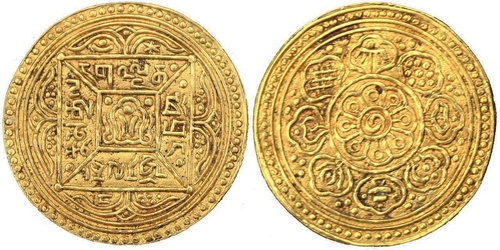
Auction: CSS41 - The Numismatic Collectors' Series sale
Lot: 2060
Tibetan Government, Anonymous (1910), gold Kelsang Tangka, 4.97g, undated, Dode mint, norbu within central square panel within a secord square divided by diagonal lines, legend (starting in the upper trapezium and continuing clockwise) dga'ldan pho brang phyogs las rnam rgyal (the Gaden Palace, victorious in all directions), beads arranged 1/2/0/1 within trapeziums, outer sections ornamented with scrolls, sun and moon in top segment, rev. two comma-shaped devices in central circle representing the nor bu dga' khyil (the whorling jewel of joy), this within a central eight-spoked wheel, surrounded by eight petals, each containing one of the eight auspicious symbols of Buddhism, three beads in each gap between the petals (Bertsch, W. "Tibet - The Monk Tangka struck in gold" JONS,vol. 221, 2014, pp.44-45; cf. KM Y#14), some surface deposits, but about as struck, good extremely fine and of the highest rarity
This is only the fourth of these rare gold Tangkas that has been recorded. One is in the British Museum (https://www.britishmuseum.org/research/collection_online/collection_object_details.aspx?assetId=805450001&objectId=3174707&partId=1). Wolfgang Bertsch records two others in private hands, one in his own collection, another sold by Stephen Album in 2012, although he mentions that one more may be in a private collection in Nepal ("Tibet - The Monk Tangka struck in gold" JONS,vol. 221, 2014, pp.44-45).
All the know gold Kelsang Tangkas are struck from same dies, which are similar to, but not the same as, silver Kelsang Tangkas with the same bead arrangement. So it appears that they may have been struck from specially prepared dies for presentation to important public figures.
Although the late Nicholas Rhodes originally considered these coins dubious, he later revised his opinion when various other gold Tibetan issues came to light. By the time he classified the Tibetan collection at the British Museum, he cast no doubt on their specimen (presented by Carlo Valdettaro in 1989). Bertsch concurs with this view and has established that his coin is of 'solid gold,' and not a gold washed specimen of the silver type.
The silver 'Monk Tangkas' are so called as they were said to have been distributed to monks during the Mönlam Festival (Great Prayer Festival) that took place after New Year's Day in February 1910. As this festival probably took place in the 'Kelsang Palace' they are also known as Kelsang Tangkas. Bertsch suggests that gold Tangkas of this type could have been intended for presentation to 'high monastic authorites or important incarnations,' of Tibet or China, an idea in accord with their raritiy and the particualr function of the silver Kelsang Tangkas.
Sold for
HK$130,000




